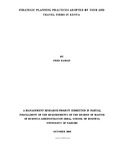| dc.description.abstract | The importance of good strategic planning is recognized by most organizations. A majority of organizations understand the need to clearly identify their mission and objectives, their priorities and targets for improvement, and the action to be taken to achieve them. Tour and travel firms in Kenya are faced with various challenges emanating from external environment such as competition, socio-cultural changes, technological changes and economic challenges. Tour and travel firms in Kenya have always been caught unprepared for such challenges and the reason could be lack of adequate planning. This is an area that has not received deserving attention from researchers. The study sought to identify strategic planning practices adopted by the travel agencies.
This research problem was studied through the use of a descriptive survey. The target population was the 250 tour operators who are active members of the Kenya Association of Tour Operators (KATO) and 45 members of Kenya Association of Travel Agents (KATA) who are not members of KATO as at December 31, 2007. The sampling technique used to select the sample was the stratified random sampling method. The tour operators were divided based on their category of membership. Five categories A, B, C, D, and E were used for the study. A sample of 20% was then picked randomly from each stratum. This brought the total sample to 54 firms. For purposes of this study, primary data was obtained through a questionnaire that was structured to meet the objectives of the study. The questions were both open and close ended. The questionnaires were administered by the researcher to the managers of the tour and travel firms selected. The SPSS (Statistical package for social sciences) computer package was used to analyze the data. Data presentation was in form descriptive statistics such as frequency distribution, percentages and tables.
As the study found, most of the firms in the industry have documented vision and mission statements which are reviewed when need arises. The companies also involve the management in the formulation of mission and vision statements. Another planning practice is that the firms in the industry do external as well as internal environmental analysis to ascertain the effects of various factors on their operations before formulating their plans. Thus, the strategic planning practice in the firms follows the formal planning process, save for the involvement of key stakeholders such as employees in the planning process. The study recommends that tour and travel firms need to have formal documented mission and vision which should be formulated by directors and the mission and vision statement should be reviewed annually. Further, the employees should also be involved in the planning process so as to expedite the implementation phase and to avoid unnecessary resistance. The study also recommends that the senior management team should be involved in gathering information from the external environment regarding, competitors, strength and capabilities, weakness and the internal analysis. This information should be used to plan effectively for fluctuations in the business such as in cases of low seasons, say, by focusing their marketing to the local tourists. | en |

